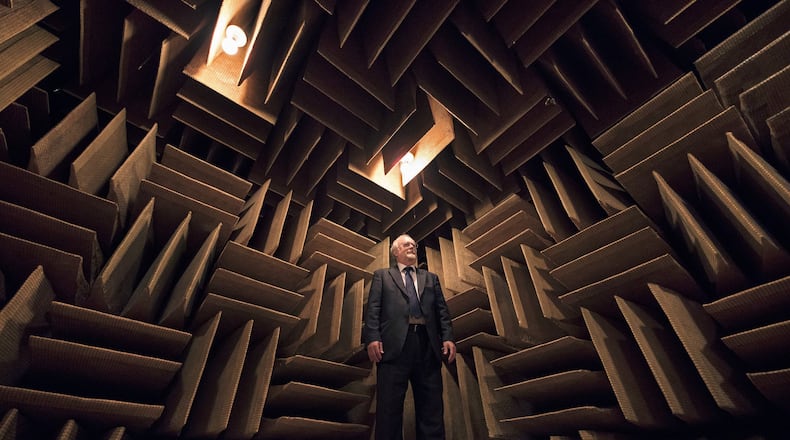MINNEAPOLIS — Inside this small room — lined on all six sides with deep, fiberglass spikes — there is no background noise. No sounds from the street, the vents, the outside world. Only silence.
But in that silence, many visitors find their own bodies become quite noisy.
Sitting in this anechoic chamber, they suddenly hear their blood flow, their inner ears buzz, their artificial heart valves click.
“Oh my goodness,” says Rita Dibble, after just four minutes in the chamber alone, “I could actually hear every vertebra.
“This is the coolest thing I’ve ever seen.”
“Or heard,” says RickAllen Meek, a lab technician who, on this afternoon, was playing tour guide.
“Or not heard,” Dibble replies, grinning.
This room, within Orfield Laboratories Inc. in south Minneapolis, is so quiet that it measures negative 13 decibels. So quiet that Guinness World Records called it “the quietest place on Earth.” So quiet that film crews, acoustics nerds and curious kids journey here just to sit inside it.
“This is a room within a room within a room,” says Steve Orfield, 69, the lab’s longtime owner, “which is why it’s so quiet.”
The anechoic chamber — one of several testing spaces within the building — feels small: 8 by 10 by 12 feet. But surrounding that space, on all six sides, are fiberglass wedges, 3 feet deep. The chamber floats on vibration-damping springs. The outermost room is made of 12-inch-thick solid concrete.
For nearly five decades, Orfield has helped companies from 3M to Medtronic understand how people experience the look and sound of their products. Having a quiet room means that Orfield and his team can test quiet things. Heart valves, CPAP machines, cellphones.
But these days, Orfield is more interested in talking about how the room might help people with post-traumatic stress disorder, autism and other hypersensitivities. Those who have sat in the chamber’s silence described how it “reset their brains,” he said. “We think there’s great potential for therapeutic uses.”
Soon after installing the anechoic chamber in the addition to this building — the former home of Sound?80 studio, where Bob Dylan famously rerecorded five songs off “Blood on the Tracks” — Orfield set up $20,000 microphones that could measure up to minus 2.5 decibels. “It floored the mics,” Orfield says.
Guinness World Records recognized the chamber as the world’s quietest place twice — at negative 9.3 decibels in 2005 and minus 13 decibels in 2013. Some context: A human infant’s hearing limit is considered to be about 0 decibels.
But in 2015, Orfield Labs got bad news. Guinness was now bestowing its “quietest” title on an anechoic chamber at Microsoft’s headquarters in Washington. Their reading hit an “unimaginably quiet -20.35 dBA,” according to Guinness’ site (dBA is a decibel measurement).
Orfield disputes the claim. His lab was held to higher standards, he pointed out, including a requirement that the reading be maintained for an hour. His anechoic chamber, too, got instantaneous readings in the negative 20s, he says.
“We’re hoping to make a claim” to regain the title, Orfield says.
But Microsoft’s title hasn’t affected interest in this Minneapolis spot. The laboratories used to do free tours, asking visitors to donate $20 to a food shelf. But the visits were taking the lab’s handful of employees away from their work. Today, the lab charges $125 a person, with a $250 minimum.
“We charge them and they come,” Orfield says. “They come from all over the world.”
Dibble, who recently moved to St. Paul, had spotted the anechoic chamber in Atlas Obscura and was intrigued. “I thought, well, everybody’s going to the Capitol and to the cathedral,” she says. “I’m going to the anechoic chamber.”
She has long sung in choirs, appreciating the grand acoustics of a domed ceiling. So Dibble was fascinated by the idea of the opposite: a room that would allow no echo. “It’s like an antidote,” she says after her hourlong tour. “Even if you love something, you occasionally need a break from it.” ?
About the Author
Keep Reading
The Latest
Featured


